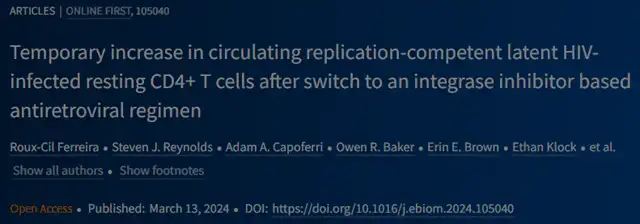Changing HIV Treatment Regimens Linked to Increase in HIV Reservoir?
- Normal Liver Cells Found to Promote Cancer Metastasis to the Liver
- Nearly 80% Complete Remission: Breakthrough in ADC Anti-Tumor Treatment
- Vaccination Against Common Diseases May Prevent Dementia!
- New Alzheimer’s Disease (AD) Diagnosis and Staging Criteria
- Breakthrough in Alzheimer’s Disease: New Nasal Spray Halts Cognitive Decline by Targeting Toxic Protein
- Can the Tap Water at the Paris Olympics be Drunk Directly?
Changing HIV Treatment Regimens Linked to Increase in HIV Reservoir?
- Should China be held legally responsible for the US’s $18 trillion COVID losses?
- CT Radiation Exposure Linked to Blood Cancer in Children and Adolescents
- FDA has mandated a top-level black box warning for all marketed CAR-T therapies
- Can people with high blood pressure eat peanuts?
- What is the difference between dopamine and dobutamine?
- How long can the patient live after heart stent surgery?
Changing HIV Treatment Regimens Linked to Increase in HIV Reservoir?
According to a new analysis of a study in Uganda, switching to an antiretroviral therapy (ART) regimen containing the drug dolutegravir is associated with a significant temporary increase in the latent HIV reservoir.
The HIV reservoir consists of cells that harbor dormant HIV and are not reached by the immune system or ART.
They are the core of persistent HIV presence, thwarting current treatment approaches from clearing the virus from the body. The findings were published in eBioMedicine.

When taken as prescribed, ART can stop HIV replication. Different classes of existing antiretroviral drugs (ARVs) interrupt different stages of HIV replication. People are often prescribed drug regimens composed of multiple drug classes to increase the likelihood of completely suppressing HIV replication.
In 2018, many countries began using dolutegravir-based antiretroviral regimens, which previous studies suggested were more effective and had fewer side effects than previously used drugs. Uganda is one of these countries and recommends the use of dolutegravir in combination with the ARVs tenofovir and lamivudine for everyone eligible for these drugs to treat HIV.
In 2015, scientists from the National Institutes of Health (NIH) in the United States and researchers from the Rakai Health Sciences Program in Uganda began a longitudinal study of HIV reservoirs in HIV-infected individuals in the Rakai and Kyotera districts of Uganda.
Study participants were people whose HIV was suppressed by ART and who agreed to provide blood samples annually and undergo routine check-ups. People who met the study entry criteria continued to enroll annually.
As part of this study, the research team examined whether the introduction of a dolutegravir-based regimen in 2018 had any impact on the HIV reservoirs of study participants.
In the published analysis, 63% of the participants were female. The study observed that the size of the HIV reservoir generally decreased because participants maintained virus suppression for a longer period. In the analysis of samples provided after the introduction of dolutegravir, they observed that the size of the HIV reservoir increased on average 1.7 times compared to pre-dolutegravir levels, which lasted for about a year and then returned to normal. This effect was consistent in most study participants, regardless of how long they had been infected with HIV.
According to the authors of the study, no other studies have found significant differences in HIV reservoir characteristics due to changes in ART regimens, but previous studies have identified changes in immune characteristics and cardiovascular disease risk, as well as other effects in the period after starting dolutegravir, indicating a period of adjustment when the body transitions to using the new drug.
The authors noted that it is important to explore whether other populations experience similar temporary increases in reservoirs after starting dolutegravir and that more research is needed to understand the mechanisms underlying the increase, especially if it starts dolutegravir or stops previous antiretrovirals.
They further suggest that these findings could provide insights for HIV treatment research, including approaches known as “shock and kill,” which attempt to stimulate HIV reservoirs to become active and then quickly clear them. The authors did not observe any negative clinical outcomes associated with this finding, such as uncontrolled viral replication.
Most studies of HIV reservoirs have been conducted in predominantly male study populations in Europe and North America, unlike in this study where the participants were mainly female.
The authors emphasize the importance of exploring gender-based differences in HIV reservoir characteristics and the importance of including representative populations in HIV research.
Changing HIV Treatment Regimens Linked to Increase in HIV Reservoir?
Reference:
RC Ferreira, et al., Temporary increase in circulating replication-competent latent HIV-infected resting CD4+ T cells after switch to an integrase inhibitor based antiretroviral regimen. eBioMedicine
(source:internet, reference only)
Disclaimer of medicaltrend.org
Important Note: The information provided is for informational purposes only and should not be considered as medical advice.



